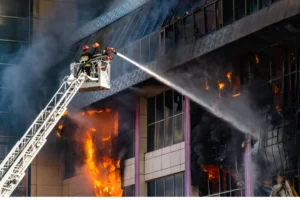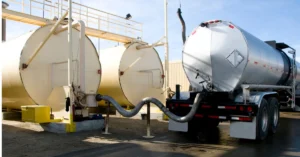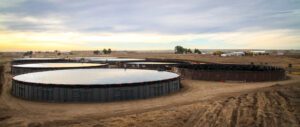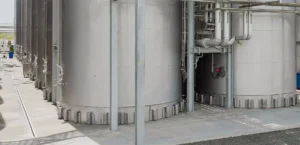Have you ever thought about what’s protecting you and your loved ones in the event of a fire? Sure, you may have smoke detectors, fire alarms, and sprinklers installed, but what’s stopping the fire itself from spreading rapidly and consuming everything in its path? The truth is, most buildings today rely on integrated foam dams as a critical line of defense against the spread of fire. Foam dams, which are made of fire-resistant materials, allow people to evacuate and emergency responders to do their jobs by containing fires to a specific area. Without these foam dams integrated into walls, floors, ceilings and ductwork, fires would spread almost instantly, putting lives and property at serious risk. These unsung heroes of fire safety deserve more recognition for the lives and property they protect each and every day.
How Fires Spread in Buildings?
Fires need three things to spread: fuel, oxygen, and an ignition source. In buildings, there are plenty of fuels – everything from furniture and paper to insulation and structural elements. And with open floor plans and HVAC systems, oxygen is rarely in short supply. All it takes is a spark from faulty wiring or a carelessly discarded cigarette, and you’ve got a blaze.

Once a fire starts, it moves fast. Flames and extreme heat travel upward, igniting anything in their path. Toxic smoke billows out, obscuring exits and choking occupants. Within minutes, an entire floor or building can become engulfed, trapping anyone still inside.
Integrated foam dams help curb this threat. Installed in walls and ceilings, these fire-resistant barriers contain a special flame-suppressing foam. When exposed to high heat, the foam rapidly expands up to 100 times its volume, sealing any cracks or openings. This cuts off the fire’s fuel supply and helps prevent smoke from spreading into other areas. The foam also releases water and chemicals as it expands to extinguish the flames.
Your building’s fire safety plan is only as strong as its weakest link. Foam dams eliminate a key vulnerability, giving occupants, property, and firefighters a much-improved chance of escaping disaster unharmed. In today’s world of open architecture and increased fire hazards, this technology has become a vital defense.
The Limitations of Traditional Firestopping Methods
Traditional firestopping methods like mineral wool, sealants, and mortars have some significant limitations.
Inadequate flexibility
These materials tend to become brittle over time, losing flexibility and the ability to expand and contract with temperature changes. This can lead to cracking and gaps, allowing fire and smoke to spread. On the other hand, integrated foam dams maintain flexibility and can compress up to 95% of their original size under pressure, re-expanding to seal any gaps when pressure is released.
Labor-intensive installation
Applying sealants, mortars and mineral wool is a labor-intensive, time-consuming process. Contractors can save hours of work by simply installing foam dams in seconds with an applicator gun. The lightweight, sticky foam securely bonds to most construction materials, including concrete, steel, drywall, and wood.
Inconsistent fire ratings
The fire ratings of traditional materials can vary depending on how well they are installed. If they are not applied properly and consistently, the firestopping abilities of these materials are compromised. Foam dams provide consistent, built-in fire ratings of up to 4 hours for walls and floors. Their intumescent properties mean they expand up to 15 times their original size when exposed to fire, creating an impenetrable barrier.
Foam dams overcome the limitations of traditional firestopping methods with their flexibility, quick and consistent installation, and dependable fire ratings. For the most advanced, fail-safe fire protection, integrated foam dams are the clear choice.
A Revolutionary Fire Protection Solution
Integrated foam dams are revolutionizing fire protection and safety. Unlike traditional fire suppression methods, integrated foam dams deploy automatically to contain and extinguish fires before they can spread.
What Are Integrated Foam Dams?
Integrated foam dams are fire-resistant barriers installed in ceilings or walls that contain built-in foam generators. In the event of a fire, the foam generators activate and fill the space between the barriers with fire-suppressing foam. The barriers prevent the foam from escaping the enclosed area, allowing it to fully extinguish the flames.
Once the fire has been put out, the foam drains away, leaving no mess or damage behind. This innovative technology helps facilities avoid costly damage and downtime in the aftermath of a fire emergency.
How Do They Work?
Integrated foam dams remain dormant until flames or extreme heat are detected in an enclosed area. When activated, they:
- Deploy barriers to seal off the space containing the fire. The barriers emerge from recessed compartments in ceilings, floors, or walls.
- Release firefighting foam to fill the enclosed space. The foam smothers flames and cools the air, extinguishing the fire quickly and safely.
-
Once the fire has been suppressed, the barriers are retracted and the excess foam is drained away. The area is left clean and undamaged, ready to resume normal operations.
Key Benefits
Compared to traditional sprinkler systems, integrated foam dams offer several advantages:
- Minimal water damage. Foam suppresses fires using a fraction of the water required for sprinklers. Sensitive equipment, documents, and other assets are protected.
- Faster response. Fire safety measures, such as integrated foam dams, activate automatically within seconds of detecting a fire. This rapid response helps contain flames before they can spread out of control.
- Flexible protection. Integrated foam dams can be installed almost anywhere, including areas where water damage could be caused or sprinklers are not feasible. They are ideal for data centers, archives, and other high-value areas.
- Cost-effective. Although integrated foam dams have higher upfront costs than basic sprinklers, they help avoid the massive costs associated with fire damage, water damage, and business interruption. For critical facilities, they provide an excellent return on investment.
Integrated foam dams represent the cutting edge of fire protection technology. For any facility looking to enhance safety, security, and business continuity, integrated foam dams should be an essential consideration. They provide an automated, waterless solution that can help put out fires fast while reducing costs and damage.
Conclusion
You now know why integrated foam dams should be a critical part of any building’s fire safety plan. They provide an effective barrier against fire and smoke, protecting people and property. As fire risks continue to increase with growing populations in urban areas and more complex building designs, integrated foam dams offer a proven solution. Peace of mind is given to you by them that if a fire were to break out, loss of life and structural damage can be minimized. While the upfront costs may seem high, the potential costs of a devastating fire make the investment well worth it. Don’t wait until it’s too late. Talk to your building owners and managers today about installing integrated foam dams. Your safety and your community’s safety depend on it.




